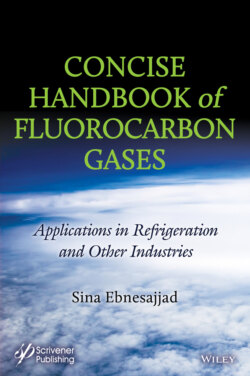Читать книгу Concise Handbook of Fluorocarbon Gases - Sina Ebnesajjad - Страница 15
1.2.1 Refrigerants: Market Trends and Supply Chain Assessment
ОглавлениеThis section has been adopted with some modifications from a Department of energy study published in May 2020 [8]. The conclusions of the reported study are listed in this section. The term refrigerants has a broad meaning in this report because most of the refrigeration gases are also used in non-refrigeration applications.
The global refrigerants market is large and is projected to grow rapidly as developing countries in warmer areas of the globe continue to grow, become more affluent, and consume more and more air conditioning, refrigeration, foam, and aerosol products and services. Innovations in the global refrigerants market is often led by major U.S. companies; however, the markets for their products are global. Understanding this global market landscape is a critical component for maintaining U.S. leadership in innovation and manufacturing in a strategically important industry.
Key Findings from the National Renewable Energy Laboratory (NREL)/Oak Ridge National Laboratory (ORNL) include:
Refrigerant markets are global and growing rapidly. 2010–2050: 4.5x increase in air conditioning for non-Organization of Economic Coordination and Development (OECD) countries (developing economies) and 1.3x increase for OECD countries (developed economies).
Regional, national, and international commitments will create large market opportunities for innovative refrigerants and products that use them.
U.S.-based companies are leaders in intellectual property and production of advanced refrigerants (Figure 1.2).
China has aggressively expanded production of conventional refrigerants for domestic use as well as export.
Refrigerants are used in large quantities for more than just cooling (Figure 1.3).
Foam production, aerosols, fire suppression, and chemical production are important end uses for these materials.
Vapor compression systems primarily use fluorocarbon refrigerants. This is the most difficult and impactful area for refrigerant innovation (Figure 1.4).
Alternative refrigerants to fluorocarbons are well established.
The refrigerant market is defined as all materials used in applications where fluorocarbons are used: vapor compression, foam blowing, aerosols, chemical feedstock, fire suppression, and solvents.
Alternative refrigerants comprise more than 50% of the total market as it exists today (Figure 1.5).
Common natural/hydrocarbon refrigerants include ammonia, pentane, carbon dioxide, propane, and butane. They have substantially lower global warming potential than most fluorocarbons.
Nonfluorinated refrigerants may provide comparable or superior performance to fluorocarbons in some end uses.
Advanced fluorocarbon refrigerants are commercially available that reduce environmental impact while maintaining or potentially improving performance (Figure 1.6).
One size doesn’t fit all—some common applications are more difficult to solve than others; this necessitates ongoing research and development.
U.S. companies are currently at the forefront of innovations.
The hydrochlorofluorocarbon phaseout is nearing completion in developed countries; attention has formally turned to the phasedown of high GWP hydrofluorocarbons with the passage of the Kigali Amendment in 2016. Significant global adoption of advanced fluorocarbon refrigerants and hydrocarbon alternatives will be instrumental to the success of this imminent HFC phasedown.
Refrigerant manufacturing locations are primarily guided by:Proximity to fluorspar, hydrofluoric acid, or other chemical feedstockExisting refrigerant manufacturing capital and experienced labor forceAvailability of cheap energy and laborFinancial incentives from local governments or development authorities.
The United States is positioned to be a major production center for advanced refrigerants, including hydrofluoroolefins (HFOs) and their blends.
Market share of production is likely to be larger if there is a substantial U.S. market for advanced refrigerants.
Fluorspar will remain in demand as manufacturers transition to producing HFOs, and the U.S. fluorspar supply is stable. Demand is now supplied mainly by Mexico, whereas historically, China had been the leading supplier.
U.S. companies, such as Honeywell and Chemours, own much of the intellectual property associated with the production and usage of HFOs.
Antidumping lawsuits regarding Chinese imports have played a major role in shaping this industry. Decisions on HFC imports have generally been in favor of U.S. companies, setting an important precedent for any future HFO-related trade disputes.
Recently constructed HFO production capacity serves as an example of the effect that financial incentives from development authorities can have on manufacturers’ plant location decisions.
Figure 1.2 Granted patents related to HFO-1234yf [8].
Figure 1.3 Global refrigerant usage, by application [8].
Figure 1.4 Global vapor compression refrigerant types [8].
Figure 1.5 Global refrigerants for all applications [8].
Figure 1.6 Groupings of refrigerants by GWP [8].
